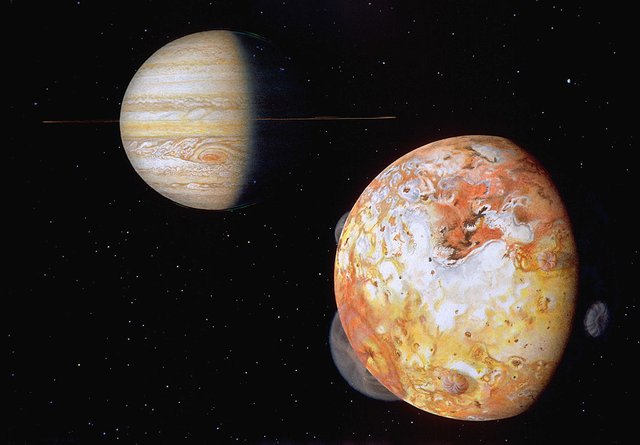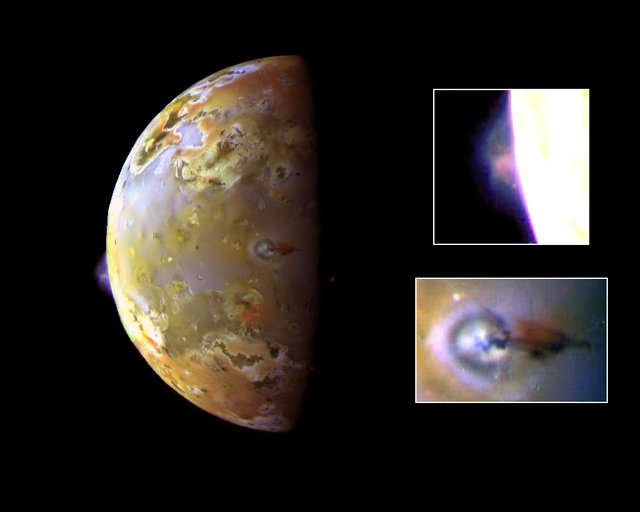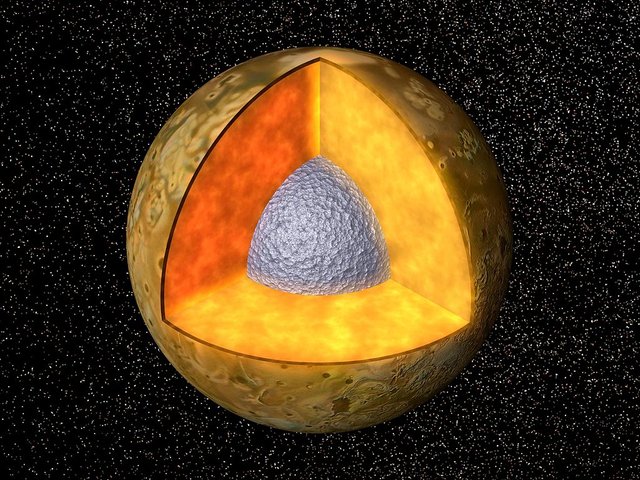Planetary moons #4 : Io
I will describe this time to you the most active moon of Jupiter - Io. It is the third largest satellite of Jupiter. Volcanoes rule its surface. Let's look at this inhospitable place.
Artist's impression of Jupiter and its moon Io as seen by the Voyager 1 space probe

By Don Davis link [Public domain]
It's the nearest moon to Jupiter. The satellite circles the planet within 42.5 hours! Its geological activity is caused by huge amounts of heat in its interior, which is caused by tidal influences. They are created by the orbital resonance with the moons of Europe and Ganymede. The Jupiter's gravitational force, changing in this way, causes moon deformation, which can reach up to 100 meters. So Io is constantly extended and squeezed. In its interior it generates friction through which huge amounts of heat are supplied to volcanoes. The surface of the satellite is constantly changing. You can't see any impact craters here. The moon has a very rare atmosphere and therefore volcanic eruptions reach up to 500 kilometers high. The remains of explosions fall to the surface. The photo below shows visible volcanic eruptions on Io.
Active Volcanic Plumes on Io

By NASA/JPL link [Public domain]
The Io diameter is 3643 km and isn't much larger than the diameter of our Earth's Moon. At the same time, Io has a much higher density, making it 21% heavier than our satellite. Its construction is similar to rocky planets. Io distinguishes the metallic core, mainly made of iron. It is estimated that its diameter can range from 700 to 1800 km! Hence, such a large mass Io. The next layer is a coat made of silicate. There is an ocean of liquid magma, located at a depth of about 50 km. The temperature here reaches 1200 degrees Celsius! The last layer is a rock crust with a thickness of 12 to 40 kilometers. Below we can see how Io looks inside.
Interior of Io

By NASA/JPL link [Public domain]
The surface of this satellite is similar to the appearance of a pizza. It is an inhospitable and uninhabited place, which is why Io's research isn't included in the JUICE mission (Jupiter Icy Moons Explorer), which will deal with Ganymede, Callisto and Europe. There is now a mission concept to explore volcanism in Io. It is called Io Volcano Observer (IVO), but its arrival in the Jupiter system will take place no earlier than in 2026.
Greetings to lovers of Astronomy!
Sources:
Io
Io Volcano Observer
Galilean moons
Jupiter
and my knowledge...
All rights reserved by @astromaniac 2018
This post has been voted on by the steemstem curation team and voting trail.
There is more to SteemSTEM than just writing posts, check here for some more tips on being a community member. You can also join our discord here to get to know the rest of the community!
It is interesting to notice that the gravitational deformations are quite visible on the pictures. Or said otherwise, we understand the pictures knowing what is going on with Jupiter's gravity.
Exactly. Jupiter's gravity is really huge. Being too close to this gas giant isn't very safe.
For a human maybe... ;)